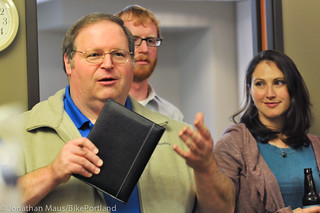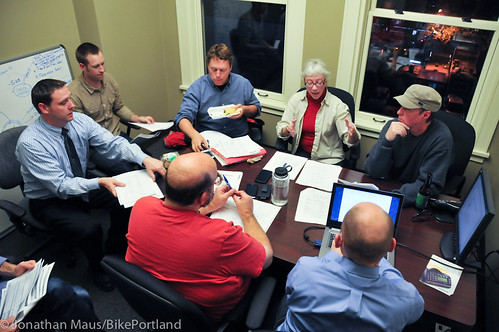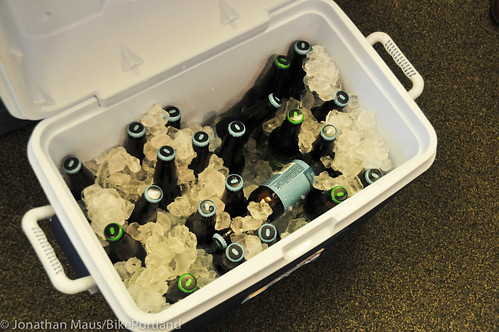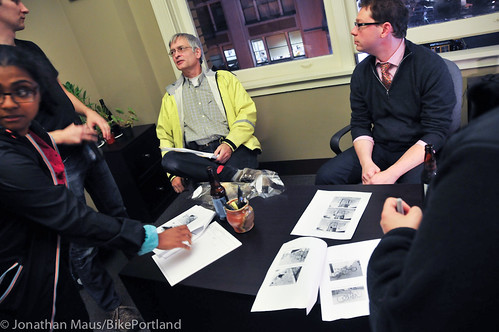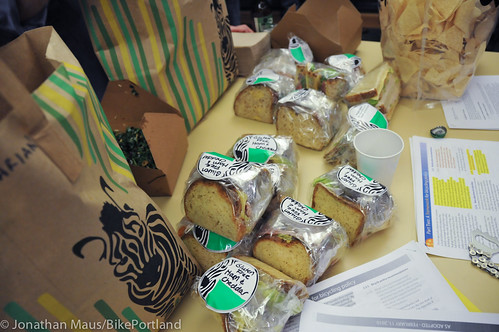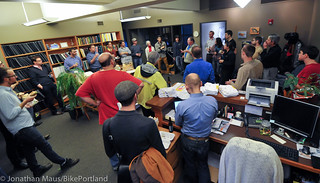
brain-power met at Lancaster Engineering
Tuesday night.
(Photos © J. Maus/BikePortland)
Staple racks at the grocery store blocked by piles of pumpkins; events with 800 people and zero additional bike parking; apartment buildings with dozens of wall hooks that are difficult and awkward to use for many people…
Portland is full of bike parking problems. Fortunately, most of them are solvable.
On Tuesday night, Jonathan and I joined the bike coordinators for Oregon’s two largest-employment universities, three representatives of bike parking equipment companies, two city employees, three architects, a team of engineers, the operator of the largest bike valet in North America and 25 other wonky Portland citizens for drinks and sandwiches to start talking about the solutions.
“In what other city,” organizer Chris Smith asked the crowd Tuesday night, “could you get 35 people to come out and talk about bike parking?”
Smith — a member of the Portland Planning and Sustainability Commission, founder of PortlandTransport.com, and noted citizen activist — ran a focused and productive event. His goal? To persuade the city’s Bureau of Transportation and the Bureau of Planning & Sustainability to begin a major update of the bike parking code. He has made a reform of the code a major priority of his second term on the planning commission.
The city’s bike parking code acts as a blueprint and legal framework for developers, landlords, homeowners, and other agencies. It tells them what type of bike parking to install, where to install it, how much of it to install, and so on. Believe it or not, the code hasn’t been updated since 1996. Since then, city planners have made tiny, incremental improvements to the code here and there; but they’ve never done a complete update.
At the Wonk Night event Tuesday night, Smith enlisted the vast transportation knowledge in our community to garner feedback on the code and collect ideas on how to reform it.
After brief introductions where each person shared their biggest bike parking gripe, attendees broke into small groups based on (but not limited to) existing subcategories in the bike parking code.
Here are some photos of the action, followed by a list of thirty ideas as shared from each group…
And here are some of the ideas they came up with…
Residential Parking:
1) Some parking should be required to be horizontal (on floor, rather than wall hooks); in San Francisco, 50% is required to be horizontal.
2) Room is needed for cargo bikes and trailers.
3) Higher ratios of parking to units may be justifiable.
4) Some portion of parking should be required to be on ground floor or parking level (rather than in living units).
5) Provide incentives in code to provide extra or higher-quality parking, such as multiple small rooms (to preserve security), climate controls or a place to hang wet clothes.
6) Provide financial incentives for landlords who retrofit additional parking into older buildings (unlinked to other redevelopment).
7) It’s OK to charge for bike parking.
Commercial Parking:
8) Link the amount of required bike parking to amount of auto parking, in ratio to the expected ratio of future trips.
9) Create a mechanism for converting auto parking to bike parking on request from building users.
10) Define bike parking as “full” when utilization hits 80%, much like the best practice for car parking.
11) Allow exceptions for auto-oriented use categories (e.g., Jiffy Lube).
12) Because keeping bike parking within 50 feet of a door is difficult with larger amounts of parking, allow a single parking facility to extend past 50 feet if it begins within 50 feet.
Transit centers:
13) Signage to bike parking is important.
14) Current code requires long-term parking to be “on site,” but OHSU’s Go By Bike valet is an example of a good facility that’s “en route” instead.
15) Current security standards in code (100 feet to security guard) don’t make much sense.
16) Card-swipe cages are missing from prominent locations like Union Station and the airport. (Indoor locations should be allowed.)
Event Parking:
17) San Francisco’s code, which requires available bike parking for 1% of expected attendees, could be useful, because it forces organizers think about bike parking without creating undue expense.
18) San Francisco also requires that bike parking be within 1/2 block of event entrance and requires that bike parking be mentioned in event advertising.
19) Since the Parks Bureau runs events, they must be involved in a fix.
Definition of parking space:
20) Abolish wave racks.
21) Require different-colored markings around bike racks to clarify where the parking space ends in order to prevent encroachment into the bike parking space.
22) Require staples be secured with tamper-proof fasteners.
23) Have dimensional standards to ensure distance from wall, etc.
24) Staples could benefit from having more than two posts, creating more places to lock to.
25) Better enforcement of four-foot distance between staples (based on 2 foot width of space as defined in code).
Additional Ideas:
26) There should be linkage between paid bike parking and paid auto parking. Conversely if auto parking is free, bike parking should be too (alternately, price ALL parking)
27) Let one building team up with another nearby one to create shared bike parking space (like the shared parking concept for auto parking).
28) Require ‘adequate’ parking rather than a particular number, making it responsive to future increases in demand.
29) Convert the second floor of city Smart Park facilities to bike parking.
30) Bike parking design/regulation must preserve pedestrian space.
What’s next? Smith said he’ll start contacting city staffers with the ultimate goal of finding money in the upcoming budget to begin an official code update project.
“I’m going to play some inside baseball for a while trying to get the bureaus on board,” Smith said. “If we get it launched, then we’re going to need community to show support for it.”
We love this project. One thing it’ll definitely have is media coverage.
— Jonathan Maus contributed to this report.
— This event was made possible by generous donations from Seattle-based bike rack company Sportworks and Omission Beer. And special thanks to Lancaster Engineering for hosting.


